Sql Antipatterns Strike Back
456 likes300,412 views
Common blunders of SQL database design, queries, and software development. Presented as a tutorial at the MySQL Conference & Expo 2009.
1 of 250
Downloaded 4,788 times














































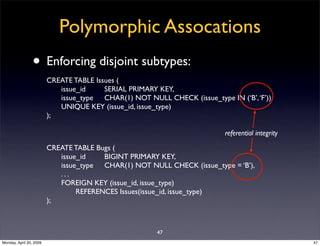














































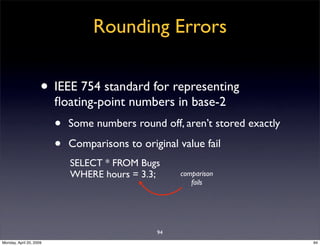














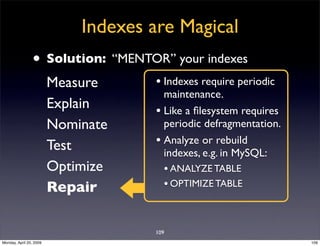











































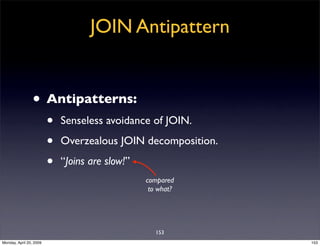





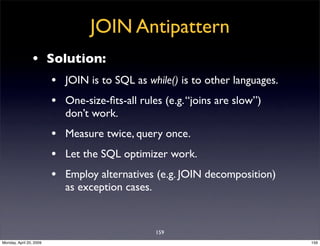


















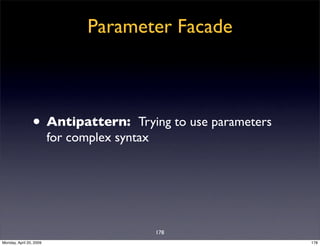






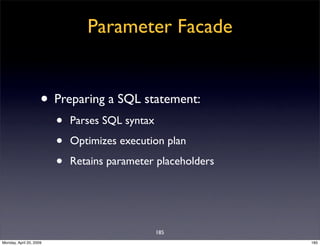



















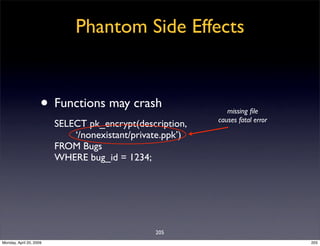


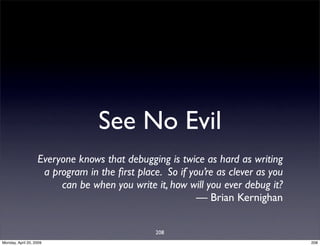

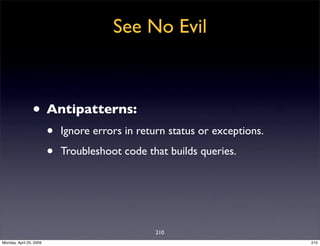


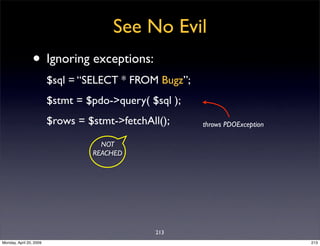



































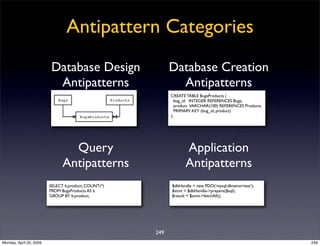

Ad
Recommended
Models for hierarchical data



Models for hierarchical dataKarwin Software Solutions LLC Tree-like data relationships are common, but working with trees in SQL usually requires awkward recursive queries. This talk describes alternative solutions in SQL, including:
- Adjacency List
- Path Enumeration
- Nested Sets
- Closure Table
Code examples will show using these designs in PHP, and offer guidelines for choosing one design over another.
Slides That Rock



Slides That RockSlides That Rock The document provides five design principles for creating slides that effectively communicate messages to audiences:
1. Focus on the main message you want the audience to remember.
2. Keep designs simple with less text and only 1 main point per slide.
3. Use interesting fonts instead of boring standard ones to engage audiences.
4. Include high quality images that visually represent the message.
5. Choose a color scheme that fits the theme and works cohesively.
VRP.pptx



VRP.pptxssuserf98ce1 This document discusses vehicle routing applications and the vehicle routing problem (VRP). It defines vehicle routing as designing and assigning routes to vehicles according to an objective function. The VRP involves figuring out optimal routes from a depot to destinations with constraints like costs, vehicle limitations, and time windows. Common types of VRPs include static and dynamic, with static having predetermined data and dynamic having changing data. Common VRPs discussed are capacitated VRP, VRP with time windows, and pickup and delivery VRP. The document notes the VRP is difficult to solve due to its complexity and discusses manual and software-based approaches to solving VRPs.
Practical Object Oriented Models In Sql



Practical Object Oriented Models In SqlKarwin Software Solutions LLC Presentation given at OSCON 2009 and PostgreSQL West 09. Describes SQL solutions to a selection of object-oriented problems:
- Extensibility
- Polymorphism
- Hierarchies
- Using ORM in MVC application architecture
These slides are excerpted from another presentation, "SQL Antipatterns Strike Back."
Trees and Hierarchies in SQL



Trees and Hierarchies in SQLEduard Hildebrandt The document discusses several models for representing hierarchical or tree-like data structures in relational databases, including adjacency list, closure table, path enumeration, nested set, and various extensions of the David Chandler model. It provides examples of creating tables and querying data for each model, and notes some advantages and limitations of each approach.
Cloud adoption fails - 5 ways deployments go wrong and 5 solutions



Cloud adoption fails - 5 ways deployments go wrong and 5 solutionsYevgeniy Brikman "All happy cloud deployments are alike; each unhappy cloud deployment is unhappy in its own way." — Leo Tolstoy, Site Reliability Engineer
At Gruntwork, I've had the chance to see the cloud adoption journeys of hundreds of companies, from tiny startups to Fortune 50 giants. I've seen those journeys go well. I've seen those journeys go poorly. In this talk, I discuss a few of the ways cloud adoption can go horribly wrong (massive cost overruns, endless death marches, security disasters), and more importantly, how you can get it right.
To help you get it right, we looked at the cloud journeys that were successful and extracted from them the patterns they had in common. We distilled all this experience down into something called the Gruntwork Production Framework, which defines five concrete steps you can follow to adopt the cloud at your own company—and hopefully, to end up with your very own happy cloud deployment.
Functional Programming Patterns (NDC London 2014)



Functional Programming Patterns (NDC London 2014)Scott Wlaschin (video of these slides available here http://fsharpforfunandprofit.com/fppatterns/)
In object-oriented development, we are all familiar with design patterns such as the Strategy pattern and Decorator pattern, and design principles such as SOLID.
The functional programming community has design patterns and principles as well.
This talk will provide an overview of some of these, and present some demonstrations of FP design in practice.
Extensible Data Modeling



Extensible Data ModelingKarwin Software Solutions LLC Designing an extensible, flexible schema that supports user customization is a common requirement, but it's easy to paint yourself into a corner.
Examples of extensible database requirements:
- A database that allows users to declare new fields on demand.
- Or an e-commerce catalog with many products, each with distinct attributes.
- Or a content management platform that supports extensions for custom data.
The solutions we use to meet these requirements is overly complex and the performance is terrible. How should we find the right balance between schema and schemaless database design?
I'll briefly cover the disadvantages of Entity-Attribute-Value (EAV), a problematic design that's an example of the antipattern called the Inner-Platform Effect, That is, modeling an attribute-management system on top of the RDBMS architecture, which already provides attributes through columns, data types, and constraints.
Then we'll discuss the pros and cons of alternative data modeling patterns, with respect to developer productivity, data integrity, storage efficiency and query performance, and ease of extensibility.
- Class Table Inheritance
- Serialized BLOB
- Inverted Indexing
Finally we'll show tools like pt-online-schema-change and new features of MySQL 5.6 that take the pain out of schema modifications.
Recursive Query Throwdown



Recursive Query ThrowdownKarwin Software Solutions LLC MySQL 8 introduces support for ANSI SQL recursive queries with common table expressions, a powerful method for working with recursive data references. Until now, MySQL application developers have had to use workarounds for hierarchical data relationships. It's time to write SQL queries in a more standardized way, and be compatible with other brands of SQL implementations. But as always, the bottom line is: how does it perform? This presentation will briefly describe how to use recursive queries, and then test the performance and scalability of those queries against other solutions for hierarchical queries.
Database Anti Patterns



Database Anti PatternsRobert Treat This document provides an overview of database anti-patterns including:
- The entity-attribute-value pattern, which stores data in a type-value format and cannot efficiently model constraints. Other options include seeking proper relational models or a "poor man's EAV" approach.
- Materialized path trees, which reference the full parent path for each child and violate normalization rules but allow retrieving the entire tree or subtrees with a single query. Moving subtrees only requires updating the path column.
- Surrogate keys, which are artificially added unique identifiers that can make queries harder to read but help ensure primary keys remain immutable.
Trees In The Database - Advanced data structures



Trees In The Database - Advanced data structuresLorenzo Alberton Storing tree structures in a bi-dimensional table has always been problematic. The simplest tree models are usually quite inefficient, while more complex ones aren't necessarily better. In this talk I briefly go through the most used models (adjacency list, materialized path, nested sets) and introduce some more advanced ones belonging to the nested intervals family (Farey algorithm, Continued Fractions, and other encodings). I describe the advantages and pitfalls of each model, some proprietary solutions (e.g. Oracle's CONNECT BY) and one of the SQL Standard's upcoming features, Common Table Expressions.
Introduction to SQL Antipatterns



Introduction to SQL AntipatternsKrishnakumar S This presentation is an introduction to SQL Antipatterns and bases on the book "SQL Antipatterns" by Bill Karwin
JPA and Hibernate



JPA and Hibernateelliando dias JPA and Hibernate are specifications and frameworks for object-relational mapping (ORM) in Java. JPA is a specification for ORM that is vendor-neutral, while Hibernate is an open-source implementation of JPA. Both use annotations to map Java classes to database tables. JPA queries use JPAQL while Hibernate supports both JPAQL and its own HQL. Additional features covered include relationships, inheritance mapping strategies, custom types, and querying.
Sql query patterns, optimized



Sql query patterns, optimizedKarwin Software Solutions LLC This document discusses various techniques for optimizing MySQL queries, including queries for exclusion joins, random selection, and greatest per group. For a query seeking movies without directors, solutions using NOT EXISTS, NOT IN, and outer joins are examined. The outer join solution performed best by taking advantage of a "not exists" optimization. For random selection of a movie, an initial naive solution using ORDER BY RAND() is shown to be inefficient, prompting discussion of alternative approaches.
Real Life Clean Architecture



Real Life Clean ArchitectureMattia Battiston We like the architecture of our applications to revolve around the business logic, not around technical details (and especially not around the database).
In my team at Sky Network Services we use the Clean Architecture and it has given us a great deal of benefits: the business logic is explicit, we are free to change our technical decisions, the app is easy to test, working on it is faster and scalable, it’s hard to do the wrong thing, and many more.
But it comes at a cost, of course. In this talk I’ll tell you the story of our experience with Clean Architecture and give you some tips to get the most out of it.
Example Project
https://github.com/mattia-battiston/clean-architecture-example
Downloads
Online: https://goo.gl/DTxftJ
PDF: https://goo.gl/ZAtdBN
Powerpoint: https://goo.gl/D54wdZ (but you need to install these fonts to see it properly: https://goo.gl/iH8SO5)
Etsy Activity Feeds Architecture



Etsy Activity Feeds ArchitectureDan McKinley The document provides an overview of the activity feeds architecture. It discusses the fundamental entities of connections and activities. Connections express relationships between entities and are implemented as a directed graph. Activities form a log of actions by entities. To populate feeds, activities are copied and distributed to relevant entities and then aggregated. The aggregation process involves selecting connections, classifying activities, scoring them, pruning duplicates, and sorting the results into a merged newsfeed.
Introduction to memcached



Introduction to memcachedJurriaan Persyn Introduction to memcached, a caching service designed for optimizing performance and scaling in the web stack, seen from perspective of MySQL/PHP users. Given for 2nd year students of professional bachelor in ICT at Kaho St. Lieven, Gent.
Anatomy of a Spring Boot App with Clean Architecture - Spring I/O 2023



Anatomy of a Spring Boot App with Clean Architecture - Spring I/O 2023Steve Pember In this presentation we will present the general philosophy of Clean Architecture, Hexagonal Architecture, and Ports & Adapters: discussing why these approaches are useful and general guidelines for introducing them to your code. Chiefly, we will show how to implement these patterns within your Spring (Boot) Applications. Through a publicly available reference app, we will demonstrate what these concepts can look like within Spring and walkthrough a handful of scenarios: isolating core business logic, ease of testing, and adding a new feature or two.
Big Data in Real-Time at Twitter



Big Data in Real-Time at Twitternkallen The document summarizes how Twitter handles and analyzes large amounts of real-time data, including tweets, timelines, social graphs, and search indices. It describes Twitter's original implementations using relational databases and the problems they encountered due to scale. It then discusses their current solutions, which involve partitioning the data across multiple servers, replicating and indexing the partitions, and pre-computing derived data when possible to enable low-latency queries. The principles discussed include exploiting locality, keeping working data in memory, and distributing computation across partitions to improve scalability and throughput.
Introduction to MongoDB



Introduction to MongoDBMike Dirolf MongoDB is an open-source, document-oriented database that provides high performance and horizontal scalability. It uses a document-model where data is organized in flexible, JSON-like documents rather than rigidly defined rows and tables. Documents can contain multiple types of nested objects and arrays. MongoDB is best suited for applications that need to store large amounts of unstructured or semi-structured data and benefit from horizontal scalability and high performance.
Railway Oriented Programming



Railway Oriented ProgrammingScott Wlaschin (Video of these slides here http://fsharpforfunandprofit.com/rop)
(My response to "this is just Either" here: http://fsharpforfunandprofit.com/rop/#monads)
Many examples in functional programming assume that you are always on the "happy path". But to create a robust real world application you must deal with validation, logging, network and service errors, and other annoyances.
So, how do you handle all this in a clean functional way? This talk will provide a brief introduction to this topic, using a fun and easy-to-understand railway analogy.
Clean architecture



Clean architectureandbed This document discusses clean architecture, which aims to separate an application into distinct layers. The core application logic is separated from the user interface and database access. This improves testability and flexibility. Some benefits of clean architecture include excellent testability since each component can be tested in isolation, clearly defined separation of concerns, and flexibility to change parts of the application independently. However, there are also costs like increased complexity with more classes and data conversions between layers.
Functional Programming Patterns (BuildStuff '14)



Functional Programming Patterns (BuildStuff '14)Scott Wlaschin (video of these slides available here http://fsharpforfunandprofit.com/fppatterns/)
In object-oriented development, we are all familiar with design patterns such as the Strategy pattern and Decorator pattern, and design principles such as SOLID.
The functional programming community has design patterns and principles as well.
This talk will provide an overview of some of these, and present some demonstrations of FP design in practice.
ES6: The Awesome Parts



ES6: The Awesome PartsDomenic Denicola The next version of JavaScript, ES6, is starting to arrive. Many of its features are simple enhancements to the language we already have: things like arrow functions, class syntax, and destructuring. But other features will change the way we program JavaScript, fundamentally expanding the capabilities of the language and reshaping our future codebases. In this talk we'll focus on two of these, discovering the the myriad possibilities of generators and the many tricks you can pull of with template strings.
Introduction to the Web API



Introduction to the Web APIBrad Genereaux The document provides an introduction to web APIs and REST. It defines APIs as methods to access data and workflows from an application without using the application itself. It describes REST as an architectural style for APIs that uses a client-server model with stateless operations and a uniform interface. The document outlines best practices for REST APIs, including using HTTP verbs like GET, POST, PUT and DELETE to perform CRUD operations on resources identified by URIs. It also discusses authentication, authorization, security concerns and gives examples of popular REST APIs from Facebook, Twitter and other services.
Spring boot Introduction



Spring boot IntroductionJeevesh Pandey Welcome to presentation on Spring boot which is really great and relatively a new project from Spring.io. Its aim is to simplify creating new spring framework based projects and unify their configurations by applying some conventions. This convention over configuration is already successfully applied in so called modern web based frameworks like Grails, Django, Play framework, Rails etc.
jQuery



jQueryJay Poojara JQuery is a JavaScript library that simplifies HTML document manipulation, event handling, animations, and Ajax interactions. It works across browsers and makes tasks like DOM traversal and manipulation, event handling, animation, and Ajax much simpler. JQuery's versatility, extensibility, and cross-browser compatibility have made it popular, with millions of developers using it to write JavaScript.
[245] presto 내부구조 파헤치기![[245] presto 내부구조 파헤치기](https://cdn.slidesharecdn.com/ss_thumbnails/245presto-150915054242-lva1-app6891-thumbnail.jpg?width=560&fit=bounds)
![[245] presto 내부구조 파헤치기](https://cdn.slidesharecdn.com/ss_thumbnails/245presto-150915054242-lva1-app6891-thumbnail.jpg?width=560&fit=bounds)
![[245] presto 내부구조 파헤치기](https://cdn.slidesharecdn.com/ss_thumbnails/245presto-150915054242-lva1-app6891-thumbnail.jpg?width=560&fit=bounds)
![[245] presto 내부구조 파헤치기](https://cdn.slidesharecdn.com/ss_thumbnails/245presto-150915054242-lva1-app6891-thumbnail.jpg?width=560&fit=bounds)
[245] presto 내부구조 파헤치기NAVER D2 Presto generates Java bytecode at runtime to optimize query execution. Key query operations like filtering, projections, joins and aggregations are compiled into efficient Java methods using libraries like ASM and Fastutil. This bytecode generation improves performance by 30% through techniques like compiling row hashing for join lookups directly into machine instructions.
How to Use JSON in MySQL Wrong



How to Use JSON in MySQL WrongKarwin Software Solutions LLC The document discusses using JSON in MySQL. It begins by introducing the speaker and outlining topics to be covered, including why JSON is useful, loading JSON data into MySQL, performance considerations when querying JSON data, using generated columns with JSON, and searching multi-valued attributes in JSON. The document then dives into examples demonstrating loading sample data from XML to JSON in MySQL, issues that can arise, and techniques for optimizing JSON queries using generated columns and indexes.
Load Data Fast!



Load Data Fast!Karwin Software Solutions LLC We all have tasks from time to time for bulk-loading external data into MySQL. What's the best way of doing this? That's the task I faced recently when I was asked to help benchmark a multi-terrabyte database. We had to find the most efficient method to reload test data repeatedly without taking days to do it each time. In my presentation, I'll show you several alternative methods for bulk data loading, and describe the practical steps to use them efficiently. I'll cover SQL scripts, the mysqlimport tool, MySQL Workbench import, the CSV storage engine, and the Memcached API. I'll also give MySQL tuning tips for data loading, and how to use multi-threaded clients.
Ad
More Related Content
What's hot (20)
Recursive Query Throwdown



Recursive Query ThrowdownKarwin Software Solutions LLC MySQL 8 introduces support for ANSI SQL recursive queries with common table expressions, a powerful method for working with recursive data references. Until now, MySQL application developers have had to use workarounds for hierarchical data relationships. It's time to write SQL queries in a more standardized way, and be compatible with other brands of SQL implementations. But as always, the bottom line is: how does it perform? This presentation will briefly describe how to use recursive queries, and then test the performance and scalability of those queries against other solutions for hierarchical queries.
Database Anti Patterns



Database Anti PatternsRobert Treat This document provides an overview of database anti-patterns including:
- The entity-attribute-value pattern, which stores data in a type-value format and cannot efficiently model constraints. Other options include seeking proper relational models or a "poor man's EAV" approach.
- Materialized path trees, which reference the full parent path for each child and violate normalization rules but allow retrieving the entire tree or subtrees with a single query. Moving subtrees only requires updating the path column.
- Surrogate keys, which are artificially added unique identifiers that can make queries harder to read but help ensure primary keys remain immutable.
Trees In The Database - Advanced data structures



Trees In The Database - Advanced data structuresLorenzo Alberton Storing tree structures in a bi-dimensional table has always been problematic. The simplest tree models are usually quite inefficient, while more complex ones aren't necessarily better. In this talk I briefly go through the most used models (adjacency list, materialized path, nested sets) and introduce some more advanced ones belonging to the nested intervals family (Farey algorithm, Continued Fractions, and other encodings). I describe the advantages and pitfalls of each model, some proprietary solutions (e.g. Oracle's CONNECT BY) and one of the SQL Standard's upcoming features, Common Table Expressions.
Introduction to SQL Antipatterns



Introduction to SQL AntipatternsKrishnakumar S This presentation is an introduction to SQL Antipatterns and bases on the book "SQL Antipatterns" by Bill Karwin
JPA and Hibernate



JPA and Hibernateelliando dias JPA and Hibernate are specifications and frameworks for object-relational mapping (ORM) in Java. JPA is a specification for ORM that is vendor-neutral, while Hibernate is an open-source implementation of JPA. Both use annotations to map Java classes to database tables. JPA queries use JPAQL while Hibernate supports both JPAQL and its own HQL. Additional features covered include relationships, inheritance mapping strategies, custom types, and querying.
Sql query patterns, optimized



Sql query patterns, optimizedKarwin Software Solutions LLC This document discusses various techniques for optimizing MySQL queries, including queries for exclusion joins, random selection, and greatest per group. For a query seeking movies without directors, solutions using NOT EXISTS, NOT IN, and outer joins are examined. The outer join solution performed best by taking advantage of a "not exists" optimization. For random selection of a movie, an initial naive solution using ORDER BY RAND() is shown to be inefficient, prompting discussion of alternative approaches.
Real Life Clean Architecture



Real Life Clean ArchitectureMattia Battiston We like the architecture of our applications to revolve around the business logic, not around technical details (and especially not around the database).
In my team at Sky Network Services we use the Clean Architecture and it has given us a great deal of benefits: the business logic is explicit, we are free to change our technical decisions, the app is easy to test, working on it is faster and scalable, it’s hard to do the wrong thing, and many more.
But it comes at a cost, of course. In this talk I’ll tell you the story of our experience with Clean Architecture and give you some tips to get the most out of it.
Example Project
https://github.com/mattia-battiston/clean-architecture-example
Downloads
Online: https://goo.gl/DTxftJ
PDF: https://goo.gl/ZAtdBN
Powerpoint: https://goo.gl/D54wdZ (but you need to install these fonts to see it properly: https://goo.gl/iH8SO5)
Etsy Activity Feeds Architecture



Etsy Activity Feeds ArchitectureDan McKinley The document provides an overview of the activity feeds architecture. It discusses the fundamental entities of connections and activities. Connections express relationships between entities and are implemented as a directed graph. Activities form a log of actions by entities. To populate feeds, activities are copied and distributed to relevant entities and then aggregated. The aggregation process involves selecting connections, classifying activities, scoring them, pruning duplicates, and sorting the results into a merged newsfeed.
Introduction to memcached



Introduction to memcachedJurriaan Persyn Introduction to memcached, a caching service designed for optimizing performance and scaling in the web stack, seen from perspective of MySQL/PHP users. Given for 2nd year students of professional bachelor in ICT at Kaho St. Lieven, Gent.
Anatomy of a Spring Boot App with Clean Architecture - Spring I/O 2023



Anatomy of a Spring Boot App with Clean Architecture - Spring I/O 2023Steve Pember In this presentation we will present the general philosophy of Clean Architecture, Hexagonal Architecture, and Ports & Adapters: discussing why these approaches are useful and general guidelines for introducing them to your code. Chiefly, we will show how to implement these patterns within your Spring (Boot) Applications. Through a publicly available reference app, we will demonstrate what these concepts can look like within Spring and walkthrough a handful of scenarios: isolating core business logic, ease of testing, and adding a new feature or two.
Big Data in Real-Time at Twitter



Big Data in Real-Time at Twitternkallen The document summarizes how Twitter handles and analyzes large amounts of real-time data, including tweets, timelines, social graphs, and search indices. It describes Twitter's original implementations using relational databases and the problems they encountered due to scale. It then discusses their current solutions, which involve partitioning the data across multiple servers, replicating and indexing the partitions, and pre-computing derived data when possible to enable low-latency queries. The principles discussed include exploiting locality, keeping working data in memory, and distributing computation across partitions to improve scalability and throughput.
Introduction to MongoDB



Introduction to MongoDBMike Dirolf MongoDB is an open-source, document-oriented database that provides high performance and horizontal scalability. It uses a document-model where data is organized in flexible, JSON-like documents rather than rigidly defined rows and tables. Documents can contain multiple types of nested objects and arrays. MongoDB is best suited for applications that need to store large amounts of unstructured or semi-structured data and benefit from horizontal scalability and high performance.
Railway Oriented Programming



Railway Oriented ProgrammingScott Wlaschin (Video of these slides here http://fsharpforfunandprofit.com/rop)
(My response to "this is just Either" here: http://fsharpforfunandprofit.com/rop/#monads)
Many examples in functional programming assume that you are always on the "happy path". But to create a robust real world application you must deal with validation, logging, network and service errors, and other annoyances.
So, how do you handle all this in a clean functional way? This talk will provide a brief introduction to this topic, using a fun and easy-to-understand railway analogy.
Clean architecture



Clean architectureandbed This document discusses clean architecture, which aims to separate an application into distinct layers. The core application logic is separated from the user interface and database access. This improves testability and flexibility. Some benefits of clean architecture include excellent testability since each component can be tested in isolation, clearly defined separation of concerns, and flexibility to change parts of the application independently. However, there are also costs like increased complexity with more classes and data conversions between layers.
Functional Programming Patterns (BuildStuff '14)



Functional Programming Patterns (BuildStuff '14)Scott Wlaschin (video of these slides available here http://fsharpforfunandprofit.com/fppatterns/)
In object-oriented development, we are all familiar with design patterns such as the Strategy pattern and Decorator pattern, and design principles such as SOLID.
The functional programming community has design patterns and principles as well.
This talk will provide an overview of some of these, and present some demonstrations of FP design in practice.
ES6: The Awesome Parts



ES6: The Awesome PartsDomenic Denicola The next version of JavaScript, ES6, is starting to arrive. Many of its features are simple enhancements to the language we already have: things like arrow functions, class syntax, and destructuring. But other features will change the way we program JavaScript, fundamentally expanding the capabilities of the language and reshaping our future codebases. In this talk we'll focus on two of these, discovering the the myriad possibilities of generators and the many tricks you can pull of with template strings.
Introduction to the Web API



Introduction to the Web APIBrad Genereaux The document provides an introduction to web APIs and REST. It defines APIs as methods to access data and workflows from an application without using the application itself. It describes REST as an architectural style for APIs that uses a client-server model with stateless operations and a uniform interface. The document outlines best practices for REST APIs, including using HTTP verbs like GET, POST, PUT and DELETE to perform CRUD operations on resources identified by URIs. It also discusses authentication, authorization, security concerns and gives examples of popular REST APIs from Facebook, Twitter and other services.
Spring boot Introduction



Spring boot IntroductionJeevesh Pandey Welcome to presentation on Spring boot which is really great and relatively a new project from Spring.io. Its aim is to simplify creating new spring framework based projects and unify their configurations by applying some conventions. This convention over configuration is already successfully applied in so called modern web based frameworks like Grails, Django, Play framework, Rails etc.
jQuery



jQueryJay Poojara JQuery is a JavaScript library that simplifies HTML document manipulation, event handling, animations, and Ajax interactions. It works across browsers and makes tasks like DOM traversal and manipulation, event handling, animation, and Ajax much simpler. JQuery's versatility, extensibility, and cross-browser compatibility have made it popular, with millions of developers using it to write JavaScript.
[245] presto 내부구조 파헤치기![[245] presto 내부구조 파헤치기](https://cdn.slidesharecdn.com/ss_thumbnails/245presto-150915054242-lva1-app6891-thumbnail.jpg?width=560&fit=bounds)
![[245] presto 내부구조 파헤치기](https://cdn.slidesharecdn.com/ss_thumbnails/245presto-150915054242-lva1-app6891-thumbnail.jpg?width=560&fit=bounds)
![[245] presto 내부구조 파헤치기](https://cdn.slidesharecdn.com/ss_thumbnails/245presto-150915054242-lva1-app6891-thumbnail.jpg?width=560&fit=bounds)
![[245] presto 내부구조 파헤치기](https://cdn.slidesharecdn.com/ss_thumbnails/245presto-150915054242-lva1-app6891-thumbnail.jpg?width=560&fit=bounds)
[245] presto 내부구조 파헤치기NAVER D2 Presto generates Java bytecode at runtime to optimize query execution. Key query operations like filtering, projections, joins and aggregations are compiled into efficient Java methods using libraries like ASM and Fastutil. This bytecode generation improves performance by 30% through techniques like compiling row hashing for join lookups directly into machine instructions.
More from Karwin Software Solutions LLC (13)
How to Use JSON in MySQL Wrong



How to Use JSON in MySQL WrongKarwin Software Solutions LLC The document discusses using JSON in MySQL. It begins by introducing the speaker and outlining topics to be covered, including why JSON is useful, loading JSON data into MySQL, performance considerations when querying JSON data, using generated columns with JSON, and searching multi-valued attributes in JSON. The document then dives into examples demonstrating loading sample data from XML to JSON in MySQL, issues that can arise, and techniques for optimizing JSON queries using generated columns and indexes.
Load Data Fast!



Load Data Fast!Karwin Software Solutions LLC We all have tasks from time to time for bulk-loading external data into MySQL. What's the best way of doing this? That's the task I faced recently when I was asked to help benchmark a multi-terrabyte database. We had to find the most efficient method to reload test data repeatedly without taking days to do it each time. In my presentation, I'll show you several alternative methods for bulk data loading, and describe the practical steps to use them efficiently. I'll cover SQL scripts, the mysqlimport tool, MySQL Workbench import, the CSV storage engine, and the Memcached API. I'll also give MySQL tuning tips for data loading, and how to use multi-threaded clients.
InnoDB Locking Explained with Stick Figures



InnoDB Locking Explained with Stick FiguresKarwin Software Solutions LLC When does InnoDB lock a row? Multiple rows? Why would it lock a gap? How do transactions affect these scenarios? Locking is one of the more opaque features of MySQL, but it’s very important for both developers and DBA’s to understand if they want their applications to work with high performance and concurrency. This is a creative presentation to illustrate the scenarios for locking in InnoDB and make these scenarios easier to visualize. I'll cover: key locks, table locks, gap locks, shared locks, exclusive locks, intention locks, insert locks, auto-inc locks, and also conditions for deadlocks.
SQL Outer Joins for Fun and Profit



SQL Outer Joins for Fun and ProfitKarwin Software Solutions LLC Many questions on database newsgroups and forums can be answered with uses of outer joins. Outer joins are part of the standard SQL language and supported by all RDBMS brands. Many programmers are expected to use SQL in their work, but few know how to use outer joins effectively.
Learn to use this powerful feature of SQL, increase your employability, and amaze your friends!
Karwin will explain outer joins, show examples, and demonstrate a Sudoku puzzle solver implemented in a single SQL query.
Survey of Percona Toolkit



Survey of Percona ToolkitKarwin Software Solutions LLC The document summarizes the Percona Toolkit, which contains free and open source command-line tools for MySQL based on Percona's experience developing best practices. Some of the most popular tools are pt-summary, pt-mysql-summary, pt-stalk, pt-archiver, and pt-query-digest, which allow users to summarize MySQL servers, analyze queries from logs, and check for issues. The toolkit can be installed via package repositories or by downloading individual tools.
How to Design Indexes, Really



How to Design Indexes, ReallyKarwin Software Solutions LLC MySQL users commonly ask: Here's my table, what indexes do I need? Why aren't my indexes helping me? Don't indexes cause overhead? This talk gives you some practical answers, with a step by step method for finding the queries you need to optimize, and choosing the best indexes for them.
Schemadoc



SchemadocKarwin Software Solutions LLC You find a column named EntityNum in a table you manage, but what data belongs in this column? Not every detail of usage is clear from just SQL data type and constraints. What is the sensible range of values? Unit of measure? How is the column used by applications? Who in the world knows? We need a way to add comments to the database schema, just as we would write comments in application code to document how programmers should use it. But comments are useful only if they're correct and current, and if they're easy to read and to update. Schemadoc is an experimental tool to help in these goals.
Percona toolkit



Percona toolkitKarwin Software Solutions LLC Using MySQL without Maatkit is like taking a photo without removing the camera's lens cap. Professional MySQL experts use this toolkit to help keep complex MySQL installations running smoothly and efficiently. This session will show you practical ways to use Maatkit every day.
MySQL 5.5 Guide to InnoDB Status



MySQL 5.5 Guide to InnoDB StatusKarwin Software Solutions LLC MySQL exposes a collection of tunable parameters and indicators that is frankly intimidating. But a poorly tuned MySQL server is a bottleneck for your PHP application scalability. This session shows how to do InnoDB tuning and read the InnoDB status report in MySQL 5.5.
Requirements the Last Bottleneck



Requirements the Last BottleneckKarwin Software Solutions LLC Software developers love tools for coding, debugging, testing, and configuration management. The more these tools improve the How of coding, the more we see that we're behind the curve on improving the What, Why, and When. If you've been on a project that seemed vague, adrift, and endless, this talk can help. Make your projects run SMART.
Mentor Your Indexes



Mentor Your IndexesKarwin Software Solutions LLC We all know how to define database indexes, but which indexes to define remains a mysterious art for most software developers. This talk will use general principles and specific scenarios to give you practical, step-by-step knowledge to turn a performance bottleneck into an epic win!
Sql Injection Myths and Fallacies



Sql Injection Myths and FallaciesKarwin Software Solutions LLC
The most massive crime of identity theft in history was perpetrated in 2007 by exploiting an SQL Injection vulnerability. This issue is one of the most common and most serious threats to web application security. In this presentation, you'll see some common myths busted and you'll get a better understanding of defending against SQL injection.
Full Text Search In PostgreSQL



Full Text Search In PostgreSQLKarwin Software Solutions LLC A comparison of different solutions for full-text search in web applications using PostgreSQL and other technology. Presented at the PostgreSQL Conference West, in Seattle, October 2009.
Ad
Recently uploaded (20)
mr discrimination__________________________________________________.pdf



mr discrimination__________________________________________________.pdfLeonid Ledata mr discrimination__________________________________________________.pdf
mr discrimination________________________________________________________1111...



mr discrimination________________________________________________________1111...Leonid Ledata mr discrimination________________________________________________________11111111111111.pdf
Best IPTV Provider 2025 Top 5 Ranked IPTV Subscriptions.pdf



Best IPTV Provider 2025 Top 5 Ranked IPTV Subscriptions.pdfMimounKhamhand1 Best IPTV Providers 2025 – Top 5 Ranked IPTV Subscriptions
your needs.
Welcome to the ultimate guide to the Best IPTV Providers in 2025. This SlideShare presentation is designed for cord-cutters, streamers, and digital entertainment enthusiasts seeking the best IPTV service that offers premium channels, fast buffering speeds, 24/7 uptime, and great customer support. Our list of the Top 5 IPTV subscriptions includes thoroughly reviewed and ranked services to help you make an informed decision.
With the growing number of IPTV services available today, it can be overwhelming to choose the right one. Many services promise unlimited channels and VOD content, but few deliver on those promises. In this guide, we've compared over 30 IPTV services and narrowed them down to the top 5 based on quality, pricing, compatibility, and user feedback.
Why IPTV Is Taking Over Traditional Cable in 2025
Traditional cable TV subscriptions continue to decline as more users switch to Internet Protocol Television (IPTV). IPTV offers a more flexible and affordable solution, giving you access to thousands of live TV channels, movies, and series from around the world, often in 4K or HD quality.
Some of the biggest advantages of IPTV include:
Access to premium international and local channels
Compatibility with Smart TVs, Firestick, Android boxes, MAG, and more
Affordable monthly or yearly plans
Massive Video on Demand (VOD) libraries
Support for sports, news, entertainment, and PPV events
No long-term contracts or hidden fees
Top 5 Ranked IPTV Subscriptions for 2025
1. Smartiflix IPTV
Smartiflix earns the top spot for its unbeatable combination of price, performance, and support. It offers over 19,000 live TV channels and more than 56,000 VOD titles. With blazing-fast servers, minimal buffering, and a user-friendly interface, Smartiflix stands out as the best all-around IPTV provider for 2025.
99.99% uptime guarantee
Compatible with all devices
24/7 customer support
Offers trial plans
Excellent reviews from thousands of users
2. TiviPortal
TiviPortal is known for its reliability and professional customer service. It features a rich selection of channels from the US, UK, Canada, and international markets, with consistent performance on even the busiest days. TiviPortal is perfect for users looking for stability and high-quality VOD content.
High channel quality
Clean EPG interface
Multiple subscription options
Easy to install and set up
Trusted by IPTV resellers
3. TrimixTriangles IPTV
TrimixTriangles is an up-and-coming IPTV service that's gaining a loyal fan base. Known for its competitive pricing, excellent sports coverage, and powerful anti-freeze tech, it’s a great option for both new and experienced users.
Great for sports fans
Modern app interface
Low subscription cost
Excellent uptime and minimal lag
4. tvworldwide.shop
tvworldwide.shop specializes in offering a vast range of international content, including niche and regional channels.
1883 Season 2_ What’s Really Going On With the Yellowstone Prequel.docx



1883 Season 2_ What’s Really Going On With the Yellowstone Prequel.docxvoice ofarticle Before diving into the reasons behind the absence of a second season, let's revisit what made 1883 Season 2 such a compelling watch. The series serves as a prequel to Yellowstone, chronicling the Dutton family's arduous journey from Texas to Montana in search of a better future. James Dutton (Tim McGraw), a Civil War veteran, leads his wife Margaret (Faith Hill), their daughter Elsa (Isabel May), and their son John through the treacherous American frontier. Their expedition is fraught with peril—disease, harsh weather, and conflicts with Native American tribes test their resilience at every turn. Elsa's narration provides a poignant lens through which viewers experience the family's trials and tribulations. Her eventual death before reaching Montana becomes a pivotal moment, prompting the Duttons to settle on the land that would become the Yellowstone Ranch .
Understanding Rich Messaging Services Enhancing Communication in the Digital ...



Understanding Rich Messaging Services Enhancing Communication in the Digital ...Times Mobile Enhance your brand communication with Times Mobile’s Rich Messaging Service. Deliver interactive, media-rich messages with images, videos, carousels, and call-to-action buttons—directly to your customers’ inbox. Improve conversions, customer engagement, and brand loyalty with personalized messaging solutions.
https://timesmobile.in/index.php/rich-communication-services
10 Best IPTV Free Trials in 2025 (Try Before You Buy).pdf



10 Best IPTV Free Trials in 2025 (Try Before You Buy).pdfBEST IPTV https://www.vpnyolo.com/best-iptv-services/
https://www.coinflexify.com/best-iptv-services/
https://www.bestipeak.com/best-iptv/
https://www.pakainfo.com/best-iptv/
https://www.yttags.com/best-iptv-service-providers.php
https://infinityknow.com/best-iptv-services/
#best iptv #iptv providers #best iptv service #iptv services #iptv usa #best iptv services #best iptv provider #iptv streamers
https://www.the-best-iptv.com/
https://www.iptvpicks.com/
https://www.vpnyolo.com/
https://www.iptv-new.com/
https://www.iptvmentor.com/
https://www.iptveye.com/
https://www.pakainfo.com/
https://www.yttags.com/
https://infinityknow.com/
Understanding Rich Messaging Services Enhancing Communication in the Digital ...



Understanding Rich Messaging Services Enhancing Communication in the Digital ...Times Mobile Enhance your brand communication with Times Mobile’s Rich Messaging Service. Deliver interactive, media-rich messages with images, videos, carousels, and call-to-action buttons—directly to your customers’ inbox. Improve conversions, customer engagement, and brand loyalty with personalized messaging solutions.
https://timesmobile.in/index.php/rich-communication-services
mr discrimination________________________________________________________1111...



mr discrimination________________________________________________________1111...Leonid Ledata mr discrimination________________________________________________________11111.pdf
Talentsskskaskkakakakak Aquisition OEC108.pptx



Talentsskskaskkakakakak Aquisition OEC108.pptxsriyansh4443 snaaamsnankaka skakakakaka skakakakkakaa sbsbxhjxnxnd
mr discrimination________________________________________________________.pdf



mr discrimination________________________________________________________.pdfLeonid Ledata mr discrimination________________________________________________________.pdf
A Hypothetical ad for ether a Video Game, TV show, Movie.



A Hypothetical ad for ether a Video Game, TV show, Movie.skylarleakeybusiness This is a Hypothetical pitch deck for a the entertainment industry
Ad









